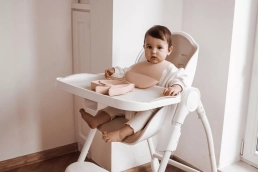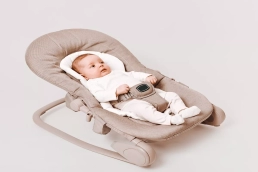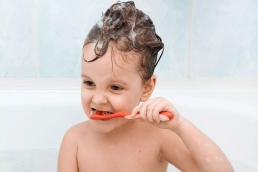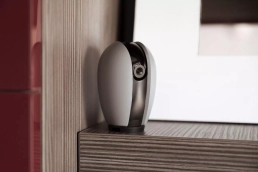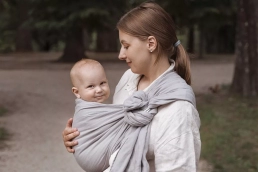As a parent, you want to ensure that your precious little one receives the best care, especially when it comes to feeding. Choosing the right baby bottle can make a significant difference in your baby’s feeding experience, promoting comfort and minimizing issues like colic and gas.
In this comprehensive guide, we have explored the best baby bottles available in the Philippines. Our selection includes top-notch options that you can easily check to make a quick, informed decision. Whether you’re a new parent or looking to upgrade your current baby bottles, this article aims to assist you in making the right choice for your baby’s well-being and contentment.
Best Overall Baby Bottle
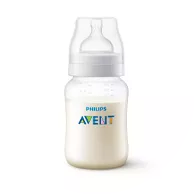
Philips Avent Anti-Colic Bottle
These bottles are well-known for reducing colic and discomfort in babies, featuring a wide neck for easy filling and cleaning, as well as a nipple designed to mimic the natural flex and movement of a mother’s breast.
Best Bottle for Newborns
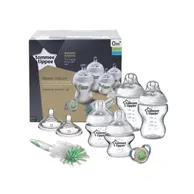
Tommee Tippee Newborn Set
The bottle features a slow flow nipple, designed to mimic the natural flex and movement of a mother’s breast, and comes with a sterilizer and bottle warmer for added convenience.
Best for Breastfed Babies
![]()
Comotomo Baby Bottles
The bottle is made of soft, squeezable silicone, replicating the feel of breastfeeding, and has a wide neck for easy cleaning. It also features a unique anti-colic vent to prevent air ingestion during feeding.
Best for Pumping Moms
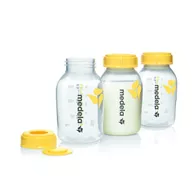
Medela Breastmilk Baby Bottles
The bottle is compatible with breast pumps, allowing for easy milk transfer, and it is specifically designed to preserve the nutrients in breast milk.
Best Bottle for Reducing Colic and Gas
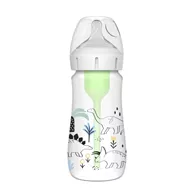
Dr. Brown's Natural Flow Bottles
The bottle features an innovative vent system that reduces colic, gas, and spit-up, while also preserving vitamins in the milk and minimizing oxidation. It is available in various sizes and nipple flow rates to suit your baby’s needs.
Best Bottle for Easy Storage and Feeding
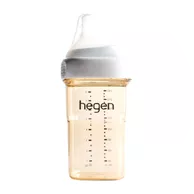
Hegen 8 oz Feeding Baby Bottle
The bottle has a unique square-shaped design, making it easy to store and stack. It also features a wide neck for easy cleaning and a one-hand closure system for convenient feeding.
Best Baby Bottle for Easy Feeding
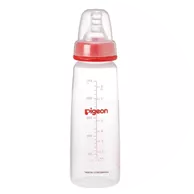
Pigeon RPP Red Baby Bottle
The bottle is made of high-quality materials and has a soft, flexible nipple, promoting a natural latch and sucking motion for your baby.
Best Bottle with Unique Nipple Design
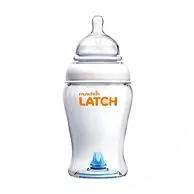
Munchkin Latch Baby Bottle
The nipple of the bottle flexes, pumps, and stretches like a mom’s breast, providing a comfortable feeding experience for your baby.
Welcoming a newborn into the world is a joyous occasion that also comes with immense responsibilities for parents. Among the essential items they need is a reliable baby bottle. Baby bottles come in a variety of shapes, sizes, and materials, making it crucial for parents to choose the best one that suits their baby’s specific needs. In the Philippines, there is a wide range of baby bottles available on the market. In this article, we will explore the best baby bottles that cater to the unique needs of babies and provide convenience for parents.
Table of Contents
ToggleBuying Guide: How to Choose the Best Baby Bottle in the Philippines
Before delving into the list of the best baby bottles, it is essential to understand the factors to consider when making a selection. These factors will ensure that you choose a bottle that aligns with your baby’s age, feeding habits, and safety requirements.
Types of Baby Bottles
When it comes to baby bottles, there are several types available, each with its own set of features and benefits:
Plastic Baby Bottles
Plastic baby bottles are a popular choice due to their affordability, lightness, and durability. They are convenient for everyday use and travel. However, it’s essential to be cautious with plastic bottles, as some may contain potentially harmful chemicals like BPA (Bisphenol A). Parents of babies with allergies or sensitivities should carefully choose BPA-free options.
Glass Baby Bottles
Glass bottles are known for their sturdiness and ease of cleaning. They are a safer option compared to some plastics, as they are free from potentially harmful chemicals. Glass bottles maintain their transparency and cleanliness over time. However, they can be heavier than plastic bottles and may pose a risk of breakage if accidentally dropped.
Silicone Baby Bottles
Silicone bottles have gained popularity for their flexibility, lightweight nature, and shatterproof properties. They are an excellent choice for parents who are often on the go and need a more durable option. Silicone bottles are soft and easy for babies to hold, making them a comfortable choice for little ones.
Nipple Materials and Flow
The material of the nipple can significantly impact your baby’s comfort during feeding. Here are some common nipple materials:
Latex Nipples
Latex nipples are known for their softness and flexibility, closely resembling the texture of a mother’s breast. This feature can make them a preferred choice for babies who are transitioning between breastfeeding and bottle feeding. However, it’s worth noting that latex nipples may wear out more quickly compared to other materials and might require more frequent replacements.
Silicone Nipples
Silicone nipples are a popular option due to their durability and ease of cleaning. They are less likely to wear out quickly, making them a long-lasting choice for baby bottles. Additionally, silicone nipples are less likely to cause allergic reactions, making them suitable for babies with sensitivities or allergies.
Nipple Shapes and Sizes
Nipples come in a variety of shapes and sizes to accommodate different feeding preferences. Here are some popular options:
Orthodontic Nipples
Orthodontic nipples are specifically designed to support the natural development of your baby’s mouth and jaw. The shape of these nipples resembles that of a mother’s breast during breastfeeding, promoting a more comfortable latch and feeding experience for the baby. These nipples are often recommended for babies who are exclusively bottle-fed or for those who have specific oral development needs.
Traditional Nipples
Traditional nipples have a rounded shape and are suitable for babies who can easily switch between breast and bottle feeding. These nipples are more commonly used as they provide a familiar feel and are generally well-accepted by babies who alternate between both feeding methods. They are a versatile option for most babies and can be found in a range of sizes and flow rates to cater to different age groups.
Anti-Colic Features
Colic can cause discomfort and fussiness in babies during feeding. When choosing baby bottles, look for ones with anti-colic features, such as venting systems. These systems are designed to reduce the intake of air while feeding, helping to minimize the occurrence of colic and providing a more comfortable feeding experience for your baby.
Ease of Cleaning
Babies require frequent feedings, making it crucial to select bottles that are easy to clean and assemble. Consider bottles with fewer parts, as they simplify the cleaning process and save you time and effort. This convenience allows you to focus more on caring for your baby.
Capacity and Graduation Marks
Baby bottles come in various sizes, ranging from small to large. Choose a bottle size that suits your baby’s feeding needs and age. Graduation marks on the bottle are helpful in monitoring your baby’s intake and ensuring they are receiving the right amount of nourishment during each feeding.
Brand Reputation and Reviews
Before making a decision, research different brands of baby bottles and read reviews from other parents. This will provide valuable insights into the bottle’s performance, durability, and safety. Opting for well-established brands with positive reviews can offer you peace of mind about the quality of the product.
BPA-Free and Phthalate-Free Bottles
Ensure that the baby bottles you choose are labeled as BPA-free and phthalate-free. These labels indicate that the bottles are made from materials that are free from potentially harmful chemicals, prioritizing the safety and well-being of your baby.
Cost Considerations
While it may be tempting to opt for cheaper options, investing in baby bottles that offer quality, safety, and convenience is essential. A higher-quality bottle may come at a slightly higher cost, but it will provide your baby with a better feeding experience and last longer, making it a worthwhile investment in your baby’s health and comfort.
Compatibility with Bottle Warmers and Sterilizers
If you plan to use baby bottle sterilizers and warmers, ensure that the baby bottles you choose are compatible with these accessories. Some bottles may not fit certain bottle warmers or sterilizers, so it’s essential to check for compatibility to ensure smooth and convenient usage of these essential baby care tools.
Portability and Travel-Friendly Bottles
For parents who are often on the go, travel-friendly baby bottles with secure lids are a must-have. These bottles are designed to be leak-proof and easy to carry, making them ideal for travel and outings. Portability features can make feeding on the go a breeze and provide convenience for busy parents.
Personalized and Fun Designs
Some baby bottles come with fun designs and vibrant colors that may appeal to your baby and make feeding time more enjoyable. Babies may be more interested in feeding from bottles that capture their attention with appealing designs, helping to create a positive feeding experience.
Trying Different Options
It’s essential to be open to trying different bottles if your baby doesn’t take to the first one you introduce. Every baby is unique, and their feeding preferences can vary. Some babies may prefer certain nipple shapes, materials, or flow rates. Being patient and willing to experiment with different bottle options can help you find the one that best suits your baby’s needs and ensures a comfortable and satisfying feeding experience for them.
Review of the Best Feeding Bottle Brands in the Philippines
1. Babyflo Quench Cup Baby Bottles

Babyflo, a Filipino brand, specializes in providing cost-effective baby bottles, making it a popular choice among budget-conscious parents. Their well-received Babyflo Quench Cup Baby Bottle serves as both a training cup and a secure option for babies during the transition from bottle to cup, thanks to its easy-grip design and safety features.
Pros:
- Cost: Babyflo bottles offer an economical alternative when compared to pricier brands.
Cons:
- Some parents may lean towards better-known brands with a substantial number of reviews and testing from other parents.
2. Chicco Natural Feeling Baby Bottle
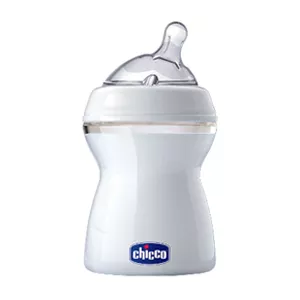
The Chicco Natural Feeling Baby Bottle offers several beneficial features, such as a dual anti-colic valve that effectively prevents the ingestion of air, thus reducing the risk of colic. The inclined nipple is thoughtfully designed to mimic the shape of the breast, promoting a comfortable and secure latch during feeding.
Pros:
- Natural Feeding Experience: Chicco NaturalFeeling Baby Bottle is specifically designed to replicate the natural breastfeeding experience, providing babies with a more comfortable and familiar feeding process.
- Comfortable and Safe: This bottle’s lightweight construction makes it easy to hold, ensuring a comfortable feeding experience for both parents and babies. Additionally, being BPA-free adds to the safety and peace of mind for parents or caregivers.
- Colic Prevention: With features aimed at reducing air intake during feeding, this bottle can be effective in preventing colic and any associated discomfort in babies.
Cons:
- Cost: It’s worth noting that silicone bottles, including the Chicco NaturalFeeling, might come at a higher price point compared to alternatives made of glass or plastic. Therefore, the cost could be a significant consideration for some parents when making their decision.
3. Comotomo Baby Bottles
![]()
Best Baby Bottle for Breastfed Babies
The Comotomo Baby Bottle stands out with its unique soft and squeezable body, which closely resembles the feeling of breastfeeding. Crafted from safe silicone material, these bottles are free from harmful chemicals like BPA and phthalates. The thoughtfully designed shape ensures both babies and parents can hold them comfortably during feeding, creating a pleasant experience for all. Additionally, the wide-neck design allows for easy cleaning without the need for a bottle brush cleaner.
Pros:
- Mimics Breastfeeding: The Comotomo Baby Bottles’ design closely imitates the shape and feel of a breast, making the transition between breast and bottle feeding smoother while preventing nipple confusion.
- Anti-Colic Vents: With built-in anti-colic vents, these bottles effectively reduce the intake of air during feeding, helping to minimize colic and discomfort in babies.
- Easy to Clean: The wide-neck design allows for effortless hand cleaning, eliminating the need for a brush and simplifying the cleaning process for caregivers.
- Soft and Hygienic Material: Made from 100% safe and hygienic silicone, these bottles ensure a gentle and comfortable experience for a baby’s mouth.
Cons:
- Cost: It’s important to note that Comotomo Baby Bottles may come at a higher price point when compared to certain other brands of baby bottles. This aspect might be a consideration for some parents while making their purchase decision.
4. Dr. Brown’s Natural Flow Bottles
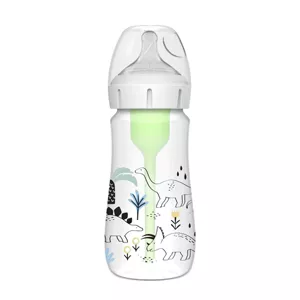
Best Baby Bottle for Reducing Colic and Gas
Dr. Brown’s Natural Flow Baby Bottle has gained acclaim for its exceptional internal vent system, effectively reducing air bubbles and preventing colic. Its positive-pressure design closely mimics breastfeeding, ensuring a comfortable and steady flow of milk. The availability of various sizes and configurations, including both narrow and wide-neck options, allows parents the flexibility to choose the one best suited to their baby’s needs.
Pros:
- Colic Reduction: Clinically proven to reduce colic in babies, Dr. Brown’s Natural Flow Bottles employ an internal vent system that minimizes air intake, thus easing colic and discomfort.
- Decreased Spit-Up and Gas: Notably, these bottles decrease instances of spit-up, burping, and gas in babies, as the vent system prevents the formation of air bubbles, reducing these common issues.
- Nutrient Preservation: Designed with the aim to better preserve the essential nutrients in breast milk and formula, Dr. Brown’s Natural Flow Bottles use the vent system to minimize oxidation, ensuring the integrity of the nutrients.
Cons:
- Cleaning: It is worth noting that Dr. Brown’s bottles consist of multiple parts, which might make them slightly more challenging to clean when compared to simpler bottle designs.
- Nipple Latch: Some parents have mentioned that the wide-neck version of the bottle could be challenging for some babies to latch onto, which is an aspect to consider while choosing the appropriate bottle for a baby.
5. Evenflo Classic Glass Twist Baby Bottle
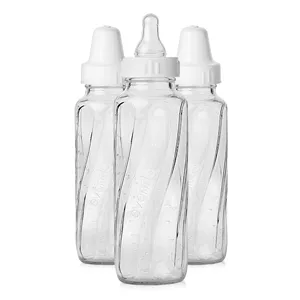
The Evenflo Classic Glass Twist Baby Bottle stands out as an eco-friendly and sustainable choice for parents, being made from recyclable and BPA-free glass. Its unique twist on an iconic, classic design adds a touch of style to the bottle. Additionally, the included classic slow flow soft silicone nipple features micro air vents to prevent nipple collapse during feeding. Available in 4-ounce and 8-ounce sizes, this bottle offers versatility to cater to different needs.
Pros:
- Eco-Friendly: The Evenflo Classic Glass Twist Baby Bottle’s recyclable and sustainable composition makes it a responsible choice for environmentally-conscious parents.
- BPA-Free: Rest assured that this bottle is made from BPA-free glass, prioritizing the safety and well-being of your baby.
- Classic Design: With its twist on an iconic, classic design, the bottle not only serves a functional purpose but also adds a unique and stylish element.
- Nipple Design: The inclusion of a classic slow flow soft silicone nipple with micro air vents contributes to a more comfortable feeding experience and helps prevent nipple collapse.
Cons:
- Fragility: Being made of glass, these bottles might be more fragile compared to plastic alternatives, potentially making them more susceptible to breaking if handled with less care.
- Cost: It’s essential to consider that glass bottles may be slightly more expensive than plastic bottles, which could be a factor to take into account when making your purchase decision.
6. Hegen 8 oz Feeding Bottle
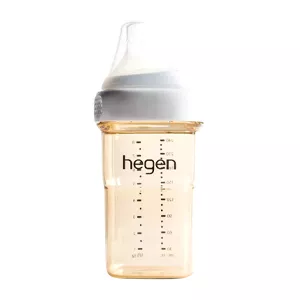
Best Baby Bottle for Easy Storage and Feeding
The Hegen 8 oz Feeding Bottle is an innovative PPSU bottle designed with several beneficial features. Its off-center and elongated nipple closely mimics the shape of mom’s breast, promoting a natural feeding experience for babies. The bottle’s rounded square shape not only makes it easy for little hands to hold but also prevents it from rolling away.
Pros:
- Unique Design: The Hegen 8 oz Feeding Bottle’s distinctive “Sqround” (square-round) shape provides excellent ergonomics, ensuring ease of holding for babies and preventing any rolling mishaps.
- Easy to Clean: Cleaning becomes a breeze with the bottle’s wide mouth and smooth lines, eliminating any fuss during the cleaning process.
- Interchangeable Lids: The Hegen bottle’s signature Sqround shape enables the use of interchangeable lids, allowing for seamless transitions between pumping, storing, and feeding breastmilk in a single bottle, without the need for transfers.
Cons:
- Cost: It’s important to note that the Hegen 8 oz Feeding Bottle might come at a higher price point when compared to certain other baby bottle brands. This aspect could be a consideration for some parents while making their purchase decision.
7. Lansinoh NaturalWave Baby Bottles
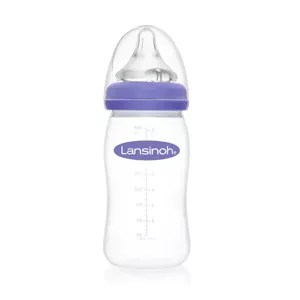
The Lansinoh NaturalWave Baby Bottle is thoughtfully crafted with inner vertical grooves on the nipple, ensuring it never collapses during feeding and closely mimics the natural breastfeeding experience. Soft and flexible nipples, combined with an air ventilation system, reduce air intake, helping to prevent colic or spit-up.
Pros:
- Breastfeeding-Friendly: Lansinoh Baby Bottles are designed to complement breastfeeding by featuring nipples that replicate the natural shape and feel of the breast, promoting a smoother transition between breast and bottle feeding.
- Anti-Colic Feature: The inclusion of an air ventilation system in Lansinoh Baby Bottles effectively reduces the intake of air during feeding, decreasing the likelihood of colic or spit-up occurrences.
- Soft and Flexible Nipples: The soft and flexible nipples of Lansinoh Baby Bottles provide babies with a comfortable feeding experience, ensuring a gentle and nurturing feeding process.
Cons:
- Cleaning: Some users may find that the bottles and nipples require extra care and attention during the cleaning process.
8. Medela Breastmilk Baby Bottles
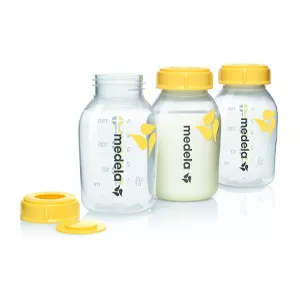
Best Baby Bottle for Pumping Moms
Medela Baby Bottles offer a variety of types, such as the Calma, Breastmilk, and Storage bottles, catering to different needs. Available in various sizes and configurations, including those with slow flow nipples for newborns, these bottles provide options for every stage of a baby’s development.
The Breastmilk bottles are specially designed to seamlessly work with Medela breast pumps and other accessories, making pumping, storing, and feeding breastmilk a convenient and integrated process for breastfeeding mothers. Additionally, Medela bottles are crafted from BPA-free materials, ensuring safety for both babies and mothers.
One of the notable advantages of Medela Baby Bottles is their breastfeeding-friendly design, featuring nipples that mimic the natural shape and feel of the breast, making the transition between breast and bottle feeding smoother.
Pros:
- Breastfeeding-Friendly: Medela Breastmilk Baby Bottles support breastfeeding babies with their nipples that closely replicate the natural shape and feel of the breast, providing comfort and familiarity during feeding.
- Versatile: Offering the ability to pump, store, and feed breastmilk, Medela Breastmilk Baby Bottles provide a convenient all-in-one solution for breastfeeding mothers.
- Anti-Colic Feature: Equipped with an air ventilation system, Medela bottles effectively reduce air intake, decreasing the likelihood of colic or spit-up, promoting a more comfortable feeding experience for babies.
Cons:
- Cost: Considering their features and versatility, Medela Breastmilk Baby Bottles might come at a higher price point compared to certain other brands of baby bottles, which could be a factor to consider while making a purchase decision.
9. Munchkin Latch Baby Bottle
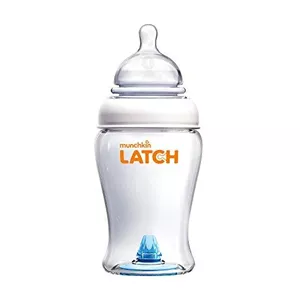
Best Baby Bottle with Unique Nipple Design
The Munchkin Latch baby bottle is ingeniously designed to emulate the natural breastfeeding experience. Its unique nipple releases more breast milk as the baby pushes against its base, closely mimicking the way babies nurse at the breast. The flexible, pumping, and stretching action of the nipple further resembles a mother’s breast, creating a comfortable and nurturing feeding experience.
Pros:
- Breastfeeding-Friendly: Munchkin baby bottles thoughtfully replicate the natural breastfeeding process, as their flexible nipples flex, pump, and stretch like a mom’s breast, making the transition between breast and bottle feeding smoother for babies.
- Anti-Colic Feature: Munchkin bottles are available in anti-colic options, which effectively reduce the risk of colic and discomfort in babies, promoting a more pleasant feeding experience.
- Easy to Clean: Munchkin baby bottles are designed for hassle-free cleaning, featuring soft silicone bottles that offer a “real” feel for babies during feeding.
Cons:
- Shape: Some users may find that the unique shape of the Munchkin baby bottle could make it slightly harder to find compatible bottle accessories, which might be a consideration for parents looking for specific accessories or replacements.
10. NUK Simply Natural Baby Bottle
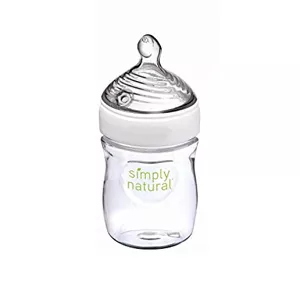
NUK Simply Natural Baby Bottles are thoughtfully designed to facilitate a smooth transition for babies from breast to bottle, replicating the fit, flow, and movement experienced during breastfeeding. These bottles feature an even softer nipple, carefully crafted to mimic the shape of mom’s breast, ensuring a comfortable and nurturing feeding experience.
One remarkable feature of NUK Simply Natural Baby Bottles is their innovative design, being the only bottles on the market with up to nine nipple holes. This unique characteristic allows for a more natural and comfortable feeding experience for babies.
Pros:
- Breastfeeding-Friendly: NUK Simply Natural Baby Bottles are specifically designed to mirror the fit, flow, and movement experienced during breastfeeding, making them an excellent option for breastfeeding babies transitioning to bottles.
- Soft and Flexible Nipples: The nipples of NUK Simply Natural Baby Bottles are soft and flexible, providing a gentle and comfortable feeding experience that closely resembles breastfeeding.
- Multiple Nipple Holes: With the distinction of having up to nine nipple holes, NUK Simply Natural Baby Bottles allow for a more natural and efficient feeding process.
Cons:
- Cleaning: Some users may find that the bottles and nipples require extra care and attention during the cleaning process.
11. Philips Avent Anti-Colic Baby Bottle
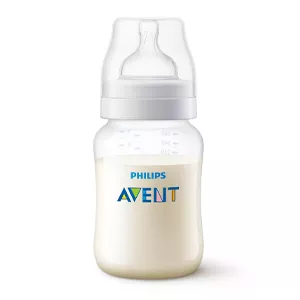
Best Overall Baby Bottle
The Philips Avent Natural Baby Bottle boasts an innovative design that closely resembles the shape and feel of a mother’s breast, facilitating a natural latch for your baby. Its inclusion of an anti-colic valve ensures a smooth and comfortable feeding experience by effectively reducing colic and discomfort. Additionally, the soft silicone nipple comes in various flow rates, enabling parents to select the most suitable option for their baby’s feeding stage.
Pros:
- Colic Reduction: The Philips Avent Anti-Colic Baby Bottle has undergone clinical testing, proving its effectiveness in reducing colic and alleviating discomfort in babies during feeding.
- Anti-Colic Valve: With an integrated anti-colic valve in the nipple, the bottle intelligently vents air into the bottle, minimizing the risk of colic and associated discomfort for babies.
- Easy to Clean: The bottle’s straightforward design and minimal parts make it easy to clean and assemble, simplifying the overall feeding process.
Cons:
- Cost: It’s important to consider that Philips Avent Anti-Colic Baby Bottles might come at a higher price point when compared to certain other brands of baby bottles. This aspect could be a consideration for some parents while making their purchase decision.
12. Pigeon RPP Red Bottle
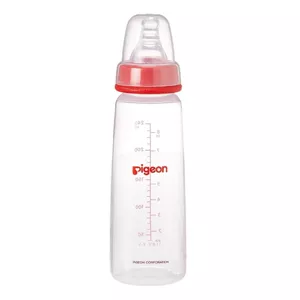
Best Baby Bottle for Easy Feeding
The Pigeon RPP Red Baby Bottle is a carefully designed baby care product, offering a safe and convenient feeding experience for infants and young children. Part of the Pigeon brand’s collection of baby bottles, it is likely crafted from RPP (Polypropylene) plastic, renowned for its durability and BPA-free properties.
Pros:
- Safe Material: The Pigeon RPP Red Baby Bottle is made from BPA-free RPP plastic, ensuring the safety and well-being of the baby during feeding.
- Durability: Thanks to its sturdy RPP plastic construction, the bottle is more resistant to accidental drops or impacts, enhancing its overall durability.
- Lightweight: The Pigeon RPP Red Bottle’s lightweight nature makes it easy for parents to handle during feeding sessions, promoting comfort and ease of use.
Cons:
- Not Suitable for Hot Liquids: It’s important to exercise caution with RPP plastic bottles, as they may not be suitable for heating or storing hot liquids.
- Limited Heat Resistance: Compared to glass bottles, RPP plastic bottles might have lower heat resistance, which means they may not be appropriate for sterilization using boiling water or high-heat methods.
13. Playtex Baby Ventaire Anti-Colic Baby Bottle

The Playtex Baby Ventaire Anti-Colic Baby Bottle is thoughtfully designed to address colic and reflux in babies, making feeding a more comfortable and pleasant experience. Its skinny bottle with an angled neck features a patented anti-colic bottom vent, which ensures air remains at the back of the bottle, preventing it from mixing with the milk.
Pros:
- Anti-Colic Design: The Playtex Baby Ventaire bottle’s innovative patented anti-colic bottom vent effectively prevents colic and reflux in babies, promoting a more relaxed and content feeding experience.
- Air-Free Feeding: Thanks to the bottom vent, the bottle promotes air-free feeding, reducing the intake of air during feeding and minimizing any potential discomfort for the baby.
- Angled Design: The angled neck design encourages a semi-upright feeding position, a recommendation from pediatricians to help prevent ear infections and enhance comfort during feeding.
Cons:
- Extra Parts: As part of its anti-colic design, the Playtex Baby Ventaire bottle includes additional parts, which may require more assembly and cleaning when compared to simpler bottle designs.
14. Pur Baby Feeding Bottles
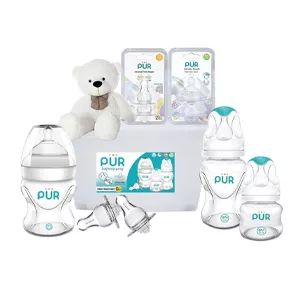
Pur Baby Bottles offer a range of baby care products, meticulously designed to deliver a safe and convenient feeding experience for infants and young children. Being part of the Pur brand’s collection, these bottles are crafted from high-quality materials and incorporate various features to enhance the feeding process.
15. Tommee Tippee CTN Newborn Starter Set
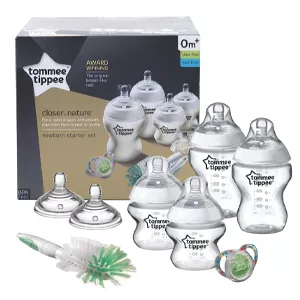
Best Baby Bottle for Newborns
The Tommee Tippee CTN Newborn Starter Set is a popular and convenient choice for parents seeking a comprehensive baby bottle set for their newborns. This starter set includes multiple bottles, nipples, and other essential accessories to simplify the feeding process.
Pros:
- Anti-colic feature: The Tommee Tippee CTN Newborn Starter Set is equipped with an anti-colic valve, effectively reducing the intake of excessive air during feeding. This feature helps minimize the occurrence of colic and discomfort in babies.
- Easy to use: With multiple pieces in the set, assembling and cleaning the bottles becomes hassle-free, saving time and effort for caregivers.
- Soft and natural feel: The soft silicone teat shape of the bottles imitates the natural feel of a breast, making it easier for babies to latch on and ensuring a comfortable feeding experience.
Cons:
- Flow rate: Some users may find that the flow rate of the nipples is too fast for their newborns, which can lead to issues such as choking and discomfort. Care should be taken to choose the appropriate nipple with the right flow rate based on the baby’s needs.
Safety Tips for Using Baby Bottles
As parents, ensuring the safety and well-being of our little ones is our top priority. One essential item we use daily for our babies is the baby bottle. While these bottles are convenient and efficient for feeding, it’s crucial to follow certain safety guidelines to protect our infants from potential hazards. Here are some valuable safety tips for using baby bottles, enabling you to provide the best care for your precious bundle of joy.
1. Choose BPA-Free Bottles
When selecting baby bottles, always opt for those labeled as “BPA-free.” Bisphenol-A (BPA) is a harmful chemical found in certain plastics that can leach into liquids, posing health risks to babies. By choosing BPA-free bottles, you can eliminate the exposure to this chemical and ensure your baby’s safety. It’s essential to prioritize your baby’s health by selecting safe and non-toxic materials for their feeding equipment. BPA-free bottles provide a safer alternative and give parents peace of mind while feeding their precious little ones.
2. Sterilize Bottles Regularly
Before using a new baby bottle and periodically afterward, it’s essential to sterilize them. Sterilization helps to kill harmful bacteria and ensures a clean environment for your baby’s feeding. Boiling the bottles in water for a few minutes or using a sterilizing solution can effectively eliminate germs. Regular sterilization is especially crucial for newborns and young infants, whose immune systems are still developing and more susceptible to infections.
To sterilize baby bottles using boiling water, follow these simple steps:
- Clean the bottles and their components thoroughly with warm soapy water, removing any milk residue or dirt.
- Place the bottles, nipples, and other parts in a large pot, ensuring they are fully submerged in water.
- Bring the water to a rolling boil and let it continue boiling for at least 5 minutes.
- Use sterilized tongs or clean hands to remove the bottles from the water, placing them on a clean, dry surface.
- Allow the bottles to cool before assembling them for use.
Alternatively, you can use a sterilizing solution or a microwave steam sterilizer following the manufacturer’s instructions. Always ensure that the bottles are completely dry before adding formula or breast milk for feeding.
By incorporating regular sterilization into your baby’s feeding routine, you create a safe and hygienic environment, protecting your little one from harmful bacteria and ensuring their health and well-being.
3. Inspect Bottles for Cracks
It’s important to inspect baby bottles for cracks, chips, or any damages on a regular basis. Damaged bottles can harbor harmful bacteria and may leak, posing choking hazards or exposing your baby to harmful substances. If you notice any signs of damage, it’s crucial to replace the bottle immediately. Keeping an eye on the condition of the bottles ensures a safe and hygienic feeding environment for your little one.
4. Avoid Using Old or Secondhand Bottles
It is best to avoid using old or secondhand baby bottles, even though they may be cost-effective. Over time, the materials in these bottles can degrade, leading to potential issues such as chemical leaching and bacterial growth. For the safety of your baby, it’s recommended to invest in new bottles that provide a clean and reliable feeding experience. Prioritizing new bottles ensures your baby’s well-being and minimizes any potential health risks associated with using older or secondhand items.
5. Use Age-Appropriate Nipples
Using age-appropriate nipples is essential when it comes to baby bottles. Nipples come in various sizes and flow rates to cater to different stages of your baby’s development. It’s crucial to match the nipple size with your baby’s needs. Using the right nipple size ensures a comfortable and smooth feeding experience, preventing any discomfort or difficulties during feeding. By choosing the appropriate nipple, you provide the best feeding support for your little one, promoting a positive and stress-free feeding routine.
6. Prepare the Formula Correctly
When preparing formula milk for your baby, it is essential to follow the instructions carefully. Properly mixing the formula ensures that your baby receives the necessary nutrition and helps prevent potential issues like underfeeding or overfeeding.
To prepare the formula correctly, measure the appropriate amount of water and formula powder according to the package instructions. Use clean, sterilized bottles and nipples for each feeding. Mixing the formula in the right proportions guarantees that your baby gets the essential nutrients needed for healthy growth and development.
By following the recommended guidelines for formula preparation, you can provide your baby with a balanced and nourishing feeding experience, supporting their overall well-being and health. Always prioritize accuracy and hygiene to ensure your little one receives the best care during feeding time.
7. Warm Bottles Safely
To warm a baby bottle safely, it’s important to avoid using the microwave, as it can create uneven hotspots, potentially causing burns to your baby’s mouth. Instead, opt for a bottle warmer or warm water bath to gently heat the milk.
Before feeding your baby, always remember to test the temperature of the milk on your wrist. The milk should be lukewarm, not too hot, to ensure a comfortable and safe feeding experience for your little one.
Prioritizing safety during the warming process ensures that your baby’s delicate mouth is protected from any potential burns, making feeding time a pleasant and worry-free moment for both of you.
8. Do Not Prop Bottles
It is crucial never to prop the baby bottle and leave your baby unattended during feedings. Propping bottles can pose serious risks, such as choking, ear infections, and tooth decay. Always hold your baby during feeding time to promote bonding and ensure close monitoring of their intake.
Holding your baby while feeding not only provides a comforting experience for them but also allows you to respond promptly to their cues and needs. This close interaction promotes a strong parent-child bond and helps you stay attentive to your baby’s feeding progress and safety.
By avoiding bottle propping and staying present during feedings, you create a nurturing and secure environment for your little one, enhancing their overall well-being and ensuring a positive feeding experience. Always prioritize your baby’s safety and cherish these precious moments of connection during feeding time.
9. Practice Safe Storage
To ensure hygiene and safe usage, practice proper storage of baby bottles when they are not in use. Store them in a clean and dry area, avoiding leaving bottles lying around where dust and debris can accumulate.
By storing the baby bottles appropriately, you maintain their cleanliness and minimize the risk of contamination, ensuring that they are ready for future use when needed. This practice contributes to a healthy and safe feeding environment for your baby, promoting their well-being and providing peace of mind for you as a parent. Remember to prioritize hygiene and cleanliness in all aspects of caring for your little one, including the storage of their feeding essentials.
10. Transition to Sippy Cups
As your baby grows older and their motor skills develop, it’s worth considering the transition from bottles to sippy cups. Sippy cups encourage independence and help reduce the risk of tooth decay that can result from prolonged bottle use.
Introducing sippy cups at the right age allows your baby to practice self-feeding and drinking, promoting their development and sense of accomplishment. Gradually making this transition can also help prevent the negative effects that extended bottle use may have on their dental health.
As with any change, be patient and supportive during the transition to sippy cups, as it may take some time for your baby to get accustomed to the new drinking method. By embracing this milestone and encouraging self-sufficiency, you contribute to your child’s growth and well-being in their journey towards becoming a more independent and confident little individual.
11. Clean Bottles Thoroughly
After each feeding, it is essential to wash the baby bottles thoroughly with warm soapy water. To ensure proper cleanliness, use a bottle brush cleaner to reach all corners of the bottle, including the nipple and cap. After washing, rinse the bottles with clean water and allow them to air dry.
Thoroughly cleaning the baby bottles after each use helps maintain hygiene and eliminates any remaining milk residue that may lead to bacterial growth. Proper cleaning and drying ensure that the bottles are ready for the next feeding, providing a safe and clean environment for your baby’s nourishment. By making regular bottle cleaning a part of your feeding routine, you ensure your little one’s well-being and create a worry-free feeding experience for both you and your baby.
12. Recognize Signs of Wear
As baby bottles age, their components may start to wear out. It is essential to regularly check the bottle’s nipple, cap, and collar for any signs of wear and tear. If you notice any damage or deterioration in these parts, it’s important to replace them as needed to maintain the bottle’s integrity.
By recognizing signs of wear and promptly replacing worn-out components, you ensure that the baby bottle remains safe and functional for your little one’s feeding needs. Prioritizing the condition of the bottle’s parts contributes to a positive and hygienic feeding experience, providing your baby with a secure and enjoyable feeding routine. Regularly inspecting and maintaining the bottle’s components will help extend its usability and ensure the best care for your precious bundle of joy.
13. Avoid Adding Honey or Sweeteners
It is crucial to avoid adding honey, sugar, or any other sweeteners to the baby’s bottle, especially for infants under one-year-old. These substances can lead to botulism, a rare but severe illness that can be harmful to babies.
Babies under the age of one year have developing immune systems and are more susceptible to the potential risks associated with honey and sweeteners. To ensure the safety and well-being of your little one, stick to age-appropriate feeding practices and avoid introducing any unnecessary sweeteners into their diet.
Providing your baby with a balanced and nutritious diet without added sugars or sweeteners is essential for their healthy growth and development. Always prioritize their well-being by adhering to recommended feeding guidelines and avoiding any potential health risks associated with the introduction of honey or sweeteners at an early age.
14. Check for Recalls
To ensure your baby’s safety, it is essential to stay informed about baby bottle recalls. Stay updated by checking with the manufacturer or relevant authorities for any potential recalls. If a bottle you own is subject to a recall, it’s crucial to follow the instructions provided by the manufacturer or authorities.
Recalls may happen due to safety concerns or issues with certain batches of baby bottles. By staying vigilant and checking for recalls, you can promptly address any potential risks and take necessary actions to protect your baby’s well-being. Following the instructions provided during a recall ensures that you take the appropriate steps to safeguard your little one from any potential hazards associated with the affected bottles.
Prioritizing safety and being proactive in checking for recalls demonstrates responsible parenting and helps provide the best care for your precious bundle of joy.
15. Be Cautious with Glass Bottles
When using glass baby bottles, exercise extra caution to prevent breakage. Never leave a baby alone with a glass bottle, as it can shatter and cause injuries.
By being mindful of the potential risks associated with glass bottles, you can ensure a safer feeding experience for your little one. Always handle glass bottles with care and supervise your baby during feedings to avoid accidents. Prioritizing their safety is crucial in creating a nurturing and secure environment during feeding time.
Opting for alternative bottle materials, such as plastic or silicone, may provide added peace of mind if you are concerned about the fragility of glass bottles. Regardless of the bottle type, practicing caution and vigilance are essential for your baby’s well-being and protection during feeding moments.
By adhering to these safety tips for using baby bottles, you can ensure a safer and more enjoyable feeding experience for your little one. Your baby’s well-being is paramount, so it’s important to select the right bottles that suit their needs, regularly sterilize them to maintain cleanliness, and handle them with care.
Ensuring safe storage and handling of baby bottles prevents contamination and maintains hygiene for your baby’s health. Additionally, being aware of your baby’s age and developmental stage allows you to introduce sippy cups at the appropriate time, promoting their growth and independence.
As a responsible parent, prioritizing your baby’s safety during feeding time contributes to their overall happiness and health. By following these guidelines, you provide a nurturing and secure environment for your precious bundle of joy, fostering a positive feeding journey and strengthening the bond between you and your baby.
Personal Insights and Recommendations
Being a parent has taught me that making the right choice when it comes to baby bottles can truly be a game-changer. When my little one arrived, I embarked on a trial-and-error journey to discover the perfect bottle that catered to her needs. My advice? While reviews can be helpful, don’t solely rely on them – trust your instincts. Pay close attention to your baby’s signals and preferences because what suits one may not suit another. Begin with a selection of different options and observe which one your baby prefers. Additionally, keep in mind that it’s not just about the bottle itself; creating a nurturing feeding experience for your precious bundle of joy also involves finding a comfortable feeding position and providing that loving touch.
FAQs About Baby Bottles
When should I introduce a baby bottle to my breastfed baby?
It’s best to wait until your baby is at least 4 to 6 weeks old and breastfeeding is well-established before introducing a baby bottle. This approach helps prevent nipple confusion and ensures a smoother transition for your baby.
Are glass baby bottles better than plastic ones?
Both glass and plastic baby bottles have their advantages and disadvantages. Glass bottles are durable, easy to clean, and free from harmful chemicals. On the other hand, plastic bottles are lightweight and less likely to shatter, making them suitable for travel.
When should I replace my baby’s bottle nipples?
Regularly check bottle nipples for signs of wear and tear, such as cracks or discoloration. Replace the nipples every two to three months or if you notice any damage to ensure your baby’s safety and hygiene.
How do I sterilize baby bottles properly?
To properly sterilize baby bottles, start by thoroughly cleaning them with warm soapy water. Boil the bottles and nipples for 5-10 minutes or use a steam sterilizer. Avoid microwaving the bottles as it may create hot spots.
What size of baby bottles should I buy?
The size of the bottle depends on your baby’s age and feeding habits. For newborns, smaller bottles with a capacity of 4-5 ounces are suitable, while older babies may require larger bottles with a capacity of 8-9 ounces.
Can I use baby bottles to feed my baby solid foods?
Baby bottles are designed for liquid feeding. Introducing solid foods should be done through spoon-feeding to ensure your baby learns proper chewing and swallowing techniques.
Are wide-neck bottles better than standard bottles?
Wide-neck bottles can be easier to clean and may mimic breastfeeding more effectively. However, the choice between wide-neck and standard bottles depends on your baby’s preference.
How can I prevent my baby from getting colic?
Colic can be reduced by choosing anti-colic baby bottles that minimize air ingestion. Additionally, burp your baby regularly during feedings and keep them in an upright position after meals.
Can I use the same bottle for different stages of my baby’s development?
Some baby bottles are designed to accommodate different nipple sizes, making them suitable for various stages of your baby’s development. Check the manufacturer’s guidelines for compatibility.
Conclusion
Selecting the right baby bottle is an important decision that can greatly impact your baby’s feeding experience. Throughout this comprehensive guide, we have explored a variety of baby bottles available in the Philippines, each offering unique features to cater to your baby’s needs. Factors such as material, design, capacity, and anti-colic features play a crucial role in making the best choice for your little one.
Our goal is to provide you with accurate and relevant information, enabling you to make an informed decision that prioritizes your baby’s comfort and well-being during feeding. With the perfect baby bottle, you can cherish the special moments of nourishing your baby and fostering a strong bond.
As you embark on this beautiful journey of parenthood, we hope our carefully curated list of the best baby bottles in the Philippines helps you find the ideal option for your precious bundle of joy. May these bottles become a part of creating cherished memories while nurturing your little one with love and care.
Written By
With a solid foundation in family dynamics, child development, and a knack for assessing products, our content is built on a strong grasp of our topics. We use trustworthy sources, seek advice from experts, and stay current with the latest happenings in our fields. We always give credit to our sources, reveal any possible conflicts of interest, and deliver info in a truthful and unbiased way. Follow us on Facebook or join our Facebook Group.
Start your journey to confident parenting
Join over 2,000+ parents who receive free practical advice and tips from Joyful PH. Unsubscribe anytime.
You may also like
11 Best Baby High Chairs in the Philippines
In the Philippines, where family meals are a cherished tradition, finding the…
11 Best Nursing Pillows in the Philippines
When it comes to nursing pillows, finding the perfect one can make a world of…
13 Best Baby Bouncers in the Philippines
The journey of baby bouncers in the Philippines is a fascinating evolution that…
13 Best Baby Toothbrushes in the Philippines
Getting the right toothbrush for your baby is essential for their oral health.…
11 Best Baby Monitors in the Philippines
Baby monitors have become a crucial tool for parents in the Philippines,…
13 Best Baby Carriers in the Philippines
When it comes to caring for your baby, choosing the right baby carrier is of…


